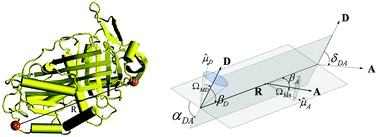On the quantitative molecular analysis of electronic energy transfer within donor–acceptor pairs†
Abstract
An extended Förster theory (EFT) on electronic energy transfer is presented for the quantitative analysis of time-resolved fluorescence lifetime and depolarisation experiments. The EFT, which was derived from the stochastic Liouville equation, yields microscopic information concerning the reorientation correlation times, the order parameters, as well as inter chromophoric distances. Weakly interacting donor and acceptor groups, which reorient and interact in a pair wise fashion, are considered, under isotropic and anisotropic conditions. For the analysis of experiments it is shown that not only do we need to consider the orientational distributions of the transition dipoles, but the internal reorienting molecular dynamics within the pair which is of even greater importance. The latter determines the shape as well as the rate of the observed donor fluorescence and depolarisation decays, which are most often not mono-exponential functions. It is shown that the commonly used Förster theory is a special case of the EFT. Strategies are presented for applying the EFT, which makes use of Brownian dynamics simulation.


 Please wait while we load your content...
Please wait while we load your content...